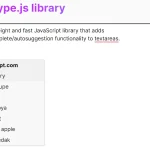| Author: | knadh |
|---|---|
| Views Total: | 745 views |
| Official Page: | Go to website |
| Last Update: | November 30, 2023 |
| License: | MIT |
Preview:

Description:
Autocomp.js is a super-tiny and blazing-fast autocomplete JavaScript library for the web.
It can fetch suggestions asynchronously from a local or remote data source and render them inline as the user types. Works with the native input field.
How to use it:
1. Install and import the autocomp.
# NPM $ npm i @knadh/autocomp
import { autocomp } from './autocomp.min.js';2. Define the suggestions that you want to show in the autocomplete dropdown menu by passing an array of strings as follows:
const suggestions = ["apple", "banana", "apricot"];
3. Initialize autocomp on an input element and specify the suggestion data source:
<input id="example" />
autocomp(document.querySelector("#example"), {
onQuery: async (val) => {
// This callback returns an array of search results.
// Typically, this will be a server side fetch() request.
// Example:
// const resp = await fetch(`/search?q=${query}`);
// const res = await response.json();
// return res;
const q = val.trim().toLowerCase();
return suggestions.filter(s => s.startsWith(q)).slice(0, 10);
},
onSelect: (val) => {
// Whatever is returned here is set in the input box.
return val;
}
});4. You can combine multiple suggestion arrays into a JS object and render the results in HTML.
const COLORS = ['#DAA520', '#228B22', '#8B4513']; const EMOJIS = ['😀', '😍', '🐱'];
autocomp(document.querySelector("#example"), {
onQuery: async (val) => {
const q = val.trim().toLowerCase();
const out = suggestions.filter(s => s.startsWith(q)).slice(0, 10);
// Results are objects:
// [{fruit: "apple", color: "..", emoji: ".."} ...]
return out.map(w => ({
fruit: w,
color: COLORS[Math.floor(Math.random() * COLORS.length)],
emoji: EMOJIS[Math.floor(Math.random() * EMOJIS.length)],
}))
},
onSelect: (o) => {
document.querySelector("#title").innerHTML = `<span style="color: ${o.color}">${o.emoji} ${o.fruit}</span>`;
document.querySelector("#object").value = o.fruit;
// Whatever is returned here is set in the input box.
return o.fruit;
},
// If this callback is set, every search item (string or object) is passed to this function and its return
// value (DOMNode), is appended to the results box.
onRender: (o) => {
const dot = document.createElement("span");
dot.style = `width: 15px; height: 15px; border-radius: 100%; display: inline-block; margin-right: 10px; float: right; background: ${o.color}`;
const d = document.createElement("span");
d.appendChild(dot);
d.appendChild(document.createTextNode(o.emoji + " "));
d.appendChild(document.createTextNode(o.fruit));
return d;
}
});Changelog:
11/30/2023
- Add tab support for selection.
11/26/2023
- Add opt.autoSelect? option to toggle default selection (first item in results) behaviour.










